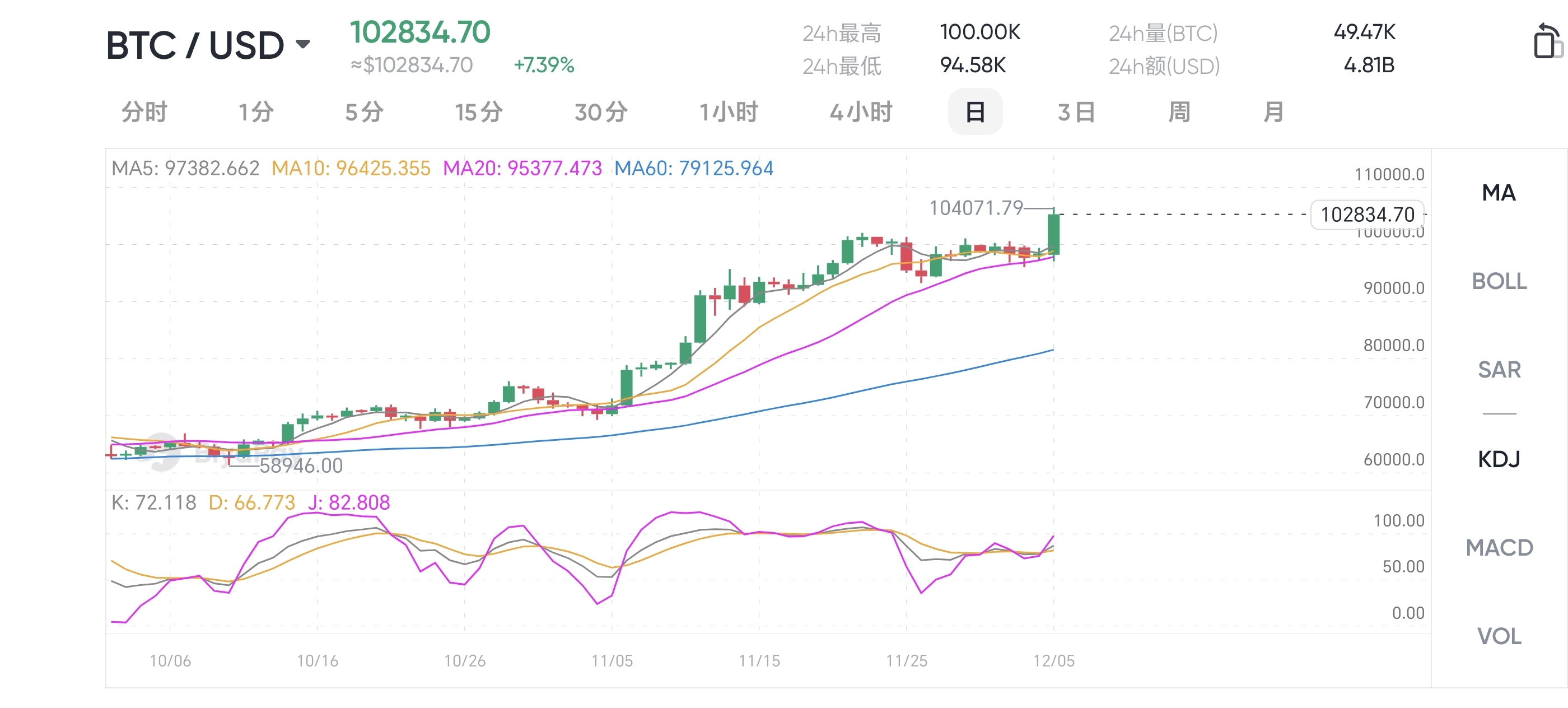On December 5th, Bitcoin officially broke through $100,000, rising over 5% in a single day, setting a new historical high. Since November 4th, Bitcoin has surged from $68,000 to $100,000 in just one month, an astonishing increase!

Why did Bitcoin strongly break through $100,000?
Firstly, the increasing uncertainty in the global economy has led investors to seek safer investment channels. Bitcoin, as a decentralized digital currency, possesses high security and anonymity, making it the preferred choice for more and more investors, thus driving the growth in Bitcoin demand.
Secondly, with the continuous development of blockchain technology, the application scenarios for digital currencies are gradually expanding. Blockchain not only provides decentralization for Bitcoin but also lays the foundation for the legitimacy and security of digital currencies, thus enhancing the value of Bitcoin as a representative of digital currencies.
In this context, Donald Trump's election as president provided a strong impetus for Bitcoin's rise. With Donald Trump being re-elected and his nominated cryptocurrency supporters gradually entering key government positions, market expectations for cryptocurrency regulation have significantly changed.
On Wednesday, Trump nominated Paul Atkins to be the chairman of the SEC. Atkins had previously opposed the SEC's crackdown on cryptocurrency companies, and his appointment is widely believed to alleviate the regulatory pressure facing the cryptocurrency industry, further boosting investor confidence in Bitcoin.
On the same day, Powell also delivered a speech emphasizing that the current low unemployment rate provides the Federal Reserve with more room for interest rate cuts, indicating that market liquidity is expected to further increase. More importantly, Powell mentioned for the first time that Bitcoin holds value like gold, which undoubtedly injected new confidence into the digital asset market and further pushed up Bitcoin's price.
Besides the changes in macroeconomic and political environments, the entry of prominent companies and institutions is also one of the important reasons for Bitcoin's price increase. This year, net inflows into the U.S. spot Bitcoin ETF have exceeded $31 billion. Additionally, Bitcoin's fourth halving event has led to a tightening of market supply, and these factors have jointly driven the surge in Bitcoin's price.
In addition, major companies like MicroStrategy and Tesla have announced large-scale purchases of Bitcoin, enhancing market confidence in Bitcoin's long-term investment value. At the same time, Microsoft is expected to announce its Bitcoin investment plan around December 10th, which will also inject a shot of confidence into Bitcoin's price.
The participation of these companies not only provides more capital inflows into Bitcoin but also enhances its market recognition and credibility. Their involvement signifies that Bitcoin is gradually moving towards the mainstream investment market, becoming the 'new favorite' of institutional investors.
What does Bitcoin reaching $100,000 mean?
Bitcoin breaking through $100,000 is seen by many as a response to the decline in the dollar's credibility, suggesting that Bitcoin's surge reflects expectations of the collapse of the dollar system.
Although Bitcoin's supply is limited and halves every four years, which gives it a sense of scarcity, attributing Bitcoin's value solely to hedging against dollar risk is overly simplistic.
In fact, the rise of Bitcoin reflects changes in the global reserve currency system. It is not intended to replace the dollar but is gradually becoming part of global asset allocation, providing a new way to store value.
The issue with U.S. debt is indeed present; the national debt has surpassed $36 trillion, with interest payments exceeding 20% of GDP annually. However, U.S. fiscal policy does not intend to genuinely repay this debt.
On the contrary, the U.S. maintains economic growth by constantly 'rolling over' its debt, and the dollar's global dominance remains solid. This means that despite the large scale of U.S. debt, the dollar is still the global reserve currency and is not easily replaceable.
The global dominance of the dollar once relied on gold, but since the collapse of the Bretton Woods system, the dollar has shifted to relying on oil. This model is gradually proving to be unsuitable with changes in the global oil market.
Today, the dollar urgently needs a new anchor to support its position in the global economy. Bitcoin, as a decentralized and borderless asset, is gradually filling this gap. It can serve as a safe-haven asset and absorb the excess dollars globally, thereby enhancing the diversity of the global financial system.
Therefore, Bitcoin's breakthrough is not only due to the weakening of the dollar's credibility but also a product of changes in the global financial landscape. As more institutional investors incorporate Bitcoin into their asset allocations, especially with the participation of large financial companies like BlackRock, Grayscale, and MicroStrategy, Bitcoin is gradually becoming a new choice for global reserve assets, positioning itself for a larger stage in the future.

How should investors respond to market volatility?
Lastly, I want to say that investing carries risks, and one must be cautious. For top experts, the joy of investing comes not just from rising asset prices but from validating their predictions based on the underlying logical analysis of the asset's price. The future of Bitcoin is promising, but this promising future comes with unknown risks. Coinglass shows that in the last 24 hours, nearly 200,000 people have been liquidated in virtual currencies, so investors should remain clear-headed and make cautious decisions.
It is worth noting that with the rise in Bitcoin's price, Bitcoin ETFs have also begun to attract capital. According to relevant data, the total assets of U.S. ETFs directly investing in Bitcoin have exceeded $100 billion.
Regarding Bitcoin's future trend, U.S. billionaire and well-known cryptocurrency investor Michael Novogratz recently stated that Bitcoin could experience a short-term drop of up to 20% after breaking through the $100,000 mark.
He believes that the leverage in the cryptocurrency community has reached its limit, and thus an adjustment will occur. Stocks and ETFs with high leverage will also face trouble. Investors should be wary of potential risks such as market volatility and regulatory uncertainty, and take appropriate risk management measures.